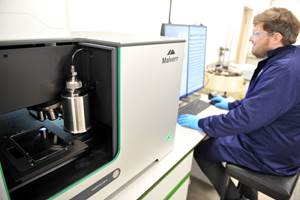Siemens’ Engineering HEEDS AI Simulation Predictor Optimizes Additive Manufacturing
The HEEDS AI Simulation Predictor empowers organizations to take full advantage of the digital twin to optimize products through advanced state-of-the-art artificial intelligence with built-in accuracy awareness.
Share
Using the HEEDS AI Simulation Predictor, innovative, high-performing designs can be produced faster by using knowledge and learnings from historical simulation studies. Source: Siemens Digital Industries Software
Siemens Digital Industries Software’s is advancing engineering simulation with the launch of two of its latest solutions — the- HEEDS AI Simulation Predictor software and Simcenter Reduced Order Modeling software. These tools empower engineers to tackle the most complex challenges manufacturers face, delivering predictive performance with speed, precision, and efficiency.
The HEEDS AI Simulation Predictor unlocks new possibilities for manufacturers by empowering engineering teams to harness the potential of advanced artificial intelligence (AI)-driven predictive modeling. As an addition to the Siemens Xcelerator portfolio, it may revolutionize design space exploration.
One key advantages is the ability to optimize products with precision. The HEEDS AI Simulation Predictor harnesses state-of-the-art AI with built-in accuracy awareness to help organizations fully leverage the digital twin to fine-tune and optimize their products with precision. Another advantage is the ability to create faster, more innovative designs. By tapping into historical simulation studies and accumulated knowledge, engineering teams can swiftly craft high-performing, innovative designs, significantly reducing time-to-market.
One of the most significant challenges in AI-powered simulation is AI drift, where models extrapolate inaccurately when faced with uncharted design spaces. To address this challenge, HEEDS AI Simulation Predictor introduces accuracy-aware AI. This technology actively self-verifies predictions, aiding engineers to conduct simulations that are not only accurate but also reliable in the context of real-world industrial engineering applications.
“With HEEDS AI Simulation Predictor, we have significantly improved various components of the gas turbine, leading to highly optimized designs and accelerated design cycles,” says Behnam Nouri, team lead, engineering and platform design, Siemens Energy. “Our thermomechanical fatigue predictions have been effectively upgraded to process approximately 20,000 design members in only 24 hours, yielding a 20% improvement in component lifetime. This has allowed us to fully characterize the limits of our existing design space which is required for high-efficiency turbine engines. The HEEDS AI Simulation Predictor technology has enabled us to save over 15,000 hours of computational time.”
The Simcenter Reduced Order Modeling software harnesses high-fidelity simulation and test data to train and validate AI/ML models. These models then enable engineers to perform predictions in a fraction of a second, transforming the way engineering professionals approach simulation.
One key advantages is speed and precision. The Simcenter Reduced Order Modeling uses high-fidelity data to empower engineers to gain rapid predictions and to make critical decisions in a fraction of the time it would take using conventional methods. It also offers predictive performance. By training AI/ML models on comprehensive datasets, this technology enables engineers to gain robust, reliable and trustworthy insights, helping to eliminate the common issue of AI drift.
“Simcenter Reduced Order Modeling lets us accelerate our simulation models to the point where a detailed fuel cell plant model runs faster than real time, with the same accuracy as a full system model,” says Jurgen Dedeurwaerder, simulation engineer, Plastic Omnium. “This enables activities such as model-in-the-loop controller development and testing to be done faster, shortening the overall development cycle by around 25%. At the same time, it gives us a reliable, IP protected and cost-effective way to distribute models to other teams, both internally and to our customers, to augment their own products and processes, resulting in better quality products delivered to end users.”
Related Content
ActivArmor Casts and Splints Are Shifting to Point-of-Care 3D Printing
ActivArmor offers individualized, 3D printed casts and splints for various diagnoses. The company is in the process of shifting to point-of-care printing and aims to promote positive healing outcomes and improved hygienics with customized support devices.
Read MoreMPI Launches AI Project to Create Material Reuse Management Tool for Metal 3D Printing
MPI is working with Additive Manufacturing Solutions and AMFG to create a versatile, commercial predictive material reuse management tool that will enable additive manufacturing to expand by introducing greater cost efficiencies.
Read More5 Observations From Dr. Tim Simpson About the State of Additive Manufacturing So Far
The outgoing co-director of Penn State’s CIMP-3D takes stock of how far AM has come, aided in no small part through the work of the organization he helped to lead.
Read MoreInspection Method to Increase Confidence in Laser Powder Bed Fusion
Researchers developed a machine learning framework for identifying flaws in 3D printed products using sensor data gathered simultaneously with production, saving time and money while maintaining comparable accuracy to traditional post-inspection. The approach, developed in partnership with aerospace and defense company RTX, utilizes a machine learning algorithm trained on CT scans to identify flaws in printed products.
Read MoreRead Next
Hybrid Additive Manufacturing Machine Tools Continue to Make Gains (Includes Video)
The hybrid machine tool is an idea that continues to advance. Two important developments of recent years expand the possibilities for this platform.
Read More4 Ways the Education and Training Challenge Is Different for Additive Manufacturing
The advance of additive manufacturing means we need more professionals educated in AM technology.
Read More3D Printing Brings Sustainability, Accessibility to Glass Manufacturing
Australian startup Maple Glass Printing has developed a process for extruding glass into artwork, lab implements and architectural elements. Along the way, the company has also found more efficient ways of recycling this material.
Read More























